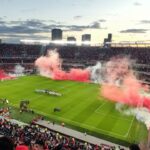


Russia has the Red Square; China, Tainanmen Square; Germany, the Berlin Wall. All are centers of public outcry and political drama. Buenos Aires has its Plaza de Mayo, which ranks among these sites for its long history as a site of public political demonstration and popular upheaval.
Bordering the Plaza are some of BA’s most notable buildings: the Casa Rosada, the official seat of the executive branch of the Argentine government; the Metropolitan Cathedral, the center of the Catholic church in Buenos Aires; the Cabildo, which served as town hall during Spain’s colonial occupation; and a financial icon, the old Bank of Boston Building. But the magic of the Plaza lies within. At its heart, the Plaza de Mayo has seen uprisings, celebrations and even bombings.
This place is even better known, however, as the meeting place of Las Madres de Plaza de Mayo. Although not initially clad in their now iconic white head scarves, which refer to the swaddling blankets of their disappeared children of the Dirty War, the Madres first appeared in the Plaza de Mayo in 1977. Since then, their quiet footsteps have brought the tragedies of an entire generation of Argentines torn apart by a cruel and repressive government to the attention of the world’s ears.
Las Madres weren’t the first group to use the Plaza as a place of protest. In 1945, the Plaza de Mayo was the site of a massive demonstration in protest of the recent arrest of then vice president and secretary of war, Juan D. Perón. Serving under a military government, Perón was incarcerated because of his move toward developing a democratic constituency of workers and trade unions. Although such organizations are today a cultural flagship of Argentine political culture, until this point in Argentine history such groups remained an untapped source of political strength. Perón’s involvement with these groups resulted in his popularity among the masses, and news of his arrest led to outrage over the scandal. Perón’s followers, including the CGT (General Confederation of Labor, a large and powerful labor union), stormed the Plaza and demanded his release from prison. The crowd’s demands were fulfilled and Perón was released, after which he was elected President of Argentina (1946) and commenced the form of governance that now is iconic of Argentine politics, Peronism.
Perón’s famous wife, Eva Duarte (or Evita), also left her mark on the Plaza. Her popularity and charisma led to a demonstration in favor of her candidacy for political leadership in 1951. Although she would stand her ground as a non-political humanitarian, the cries of the 2 million people in favor of a female political leader rang loud and clear through the Plaza. Later that year, Evita’s dying words were broadcast to supporters and admirers from the famous balcony overlooking the Plaza.
The Plaza has not always been so peaceful. Perón took the stage again on June 15, 1955 in order to address his recent excommunication from the Catholic Church. It was then that the Plaza turned violent, as the military power structure attempting to stage a coup against the president. Sending Navy fighter jets to drop bombs on the Plaza, this failed coup resulted in the deaths of 364 innocent civilians in the space below. The Massacre of the Plaza de Mayo marked the beginning of the end of Perón’s first presidency and that of his political exile. After this event, the Peronist party was also prohibited from appearing on Argentine electoral ballots.
The next chapter in the Plaza’s history is one of sadness and bravery. During the last military junta, the word deseparacido took on a whole new meaning. People were being erased, or disappeared. The unjust kidnapping, torture and murder associated with the military leadership caused many to flee, hide, take up arms, and filled others with such desperation to find their loved ones that they risked their lives to walk the Plaza, as symbols of peace and justice.

Drawn to the Plaza for the exposure, the mothers began meeting and circling the Plaza wearing white headscarves embroidered with the name of the child they were searching for, and waited for a national and global audience. They would have a long wait, but eventually the Madres became symbols of the struggle of the powerless. Today, the mothers and grandmothers are still working to find the children of the disappeared, who were adopted to new families by the military government and who still do not know their own stories. Thanks to the efforts of the Madres, almost 100 of these sons and daughters of the disappeared have now recovered their identities.
Also during the last military leadership, several rallies were held in the Plaza for the Guerra de las Malvinas, another tragic memory for the Argentines of this generation. The invasion and brief recuperation of the islands became a symbol of patriotism and unification for a struggling military leadership. The immediate support of the people quickly shifted, however, as it became clear that Great Britain would not let the islands go without a fight, leaving many young soldiers dead, and the lives of countless others left destroyed by the fighting. The gatherings in the Plaza that followed the Malvinas conflict symbolized the need for change and welcomed the return of democracy in 1983.
The Plaza again took centerstage during the economic crisis of 2001-02. Marking the end of one-to-one convertibility, a political and economic strategy begun in 1991 which fixed the value of the Argentine peso to that of the US dollar, the end of the year 2001 was a tumultuous time of political corruption and resignations. After the disolution of the convertibility rule, crisis and mass protest broke out in all corners of Buenos Aires, resulting in the successive resigations and appointments of 5 presidents within the span of one month. The riots and protests begun in December 2001 initiated the current political climate of today’s Argentina, as it was with these protests that also came the birth of the piqetero movement, cortes de ruta , and street marches that all started with the Plaza de Mayo.
Emily Farrin
LPBA Staff
(US) 910 795 2992
(AR) +54 9 11 —- —-
©Copyright 2025 Landingpadba, LLC